
July 2022
By the ACHPER NSW Professional Learning Team
The Australian Institute of Health and Welfare (AIHW) has released Australia’s Health 2022. ACHPER NSW has compiled the top-level highlights with teaching notes for Stage 6 PDHPE.
We’ll publish a series of summaries in the coming weeks. The first looks at morbidity and mortality.
Australians and COVID-19
COVID-19 is continuing to affect the health and wellbeing of Australians. Since the start of the pandemic Australia has reported*:
- 8,511,844 total cases
- 74,747,685 total tests
- 10,326 total deaths.
Graph 1: COVID-19 case numbers and statistics
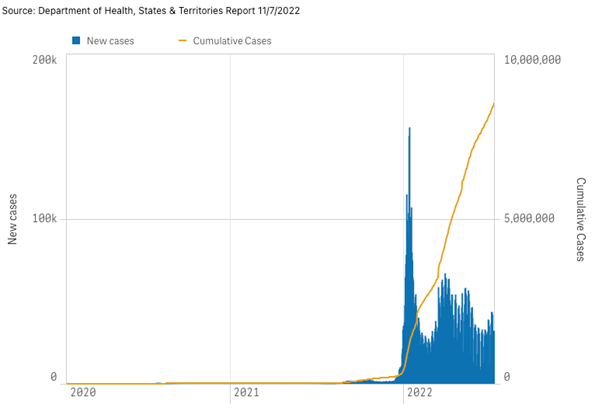
* Source: Department of Health and Ageing, 2022, COVID-19 Case Numbers and Statistics. Accessed on 12 July 2022.
Graph 1 above shows:
- There are a significantly larger number of COVID cases in 2022 compared to 2020/2021.
- The larger number of cases in 2022 means that hospitalisation and number of deaths attributed to COVID are higher than 2020/2021. This is despite COVID now being less likely to cause severe illness and death than it was in 2020/2021.
Teaching note:
Graph 1 shows the total number of new COVID-19 cases in Australia reported by states and territories over time and the cumulative number of confirmed COVID-19 cases reported over time. It is a good illustration of multiple data sets and axis to unpack with your students:
- Blue bar chart line – shows the newly confirmed COVID-19 cases by notification received date.
- Orange line graph – shows the cumulative number of newly confirmed COVID-19 cases by notification received date.
- Horizontal axis – shows the date of notification to state and territory health departments.
- Vertical axis on the left – shows the number of new COVID-19 cases, represented by the bars.
- Vertical axis on the right – shows the cumulative number of COVID-19 cases, represented by the line.
COVID-19 case study: the daily COVID-19 case number updates increased the visibility of epidemiology at work. The high profile of epidemiologists in the media provides a case study opportunity for Core 1 revision in preparation for trials or HSC exams. ACHPER NSW board member Luke Adams has developed a template for a COVID-19 case study.
Causes of death in Australia
Over the last century, death rates have continuously declined but the leading causes of death have changed:
- Deaths from infectious diseases have decreased
- Deaths from chronic conditions, such as cancers and dementia, have increased.
Graph 2: Cause of death for Australians
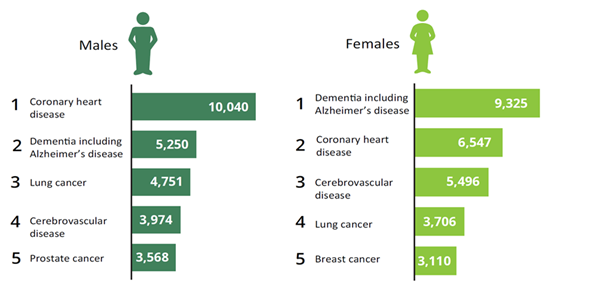
Source: AIHW, 2022, Australia’s Health Summary Report. Accessed on 12 July 2022.
Leading cause of death differs by age:
- People aged over 45 years – chronic conditions feature more prominently
- People aged 1-44 years – external causes, such as accidents and suicide are leading causes.
Teaching note:
Direct your students to Chapter 4 of Australia’s Health 2022 to find out more about the leading causes of death.
Burden of disease in Australia
In 2018, the 5 diseases that caused the most burden overall were chronic conditions:
- Coronary heart disease 6.3%
- Back pain and problems 4.5%
- Dementia 4%
- Chronic obstructive pulmonary disease 3.5%
- Lung cancer 3.2%
Source: AIHW, 2022, Australia’s Health Summary Report. Accessed on 12 July 2022.
Chronic conditions are an ongoing cause of substantial ill health, disability and premature death, making them an important global, national and individual health concern.
- In 2020-21 – almost half of Australians (47%, or 11.6 million people) were estimated to have one or more of 10 selected chronic conditions (including arthritis, asthma, back problems, diabetes and mental and behavioural conditions).
- In 2017-2018 – an estimated 20% of people (4.9 million) had 2 or more conditions in 2017–18.
Coronary heart disease (CHD)
CHD is the leading single cause of disease burden and death in Australia. CHD occurs when there is a narrowing or blockage in the blood vessels that supply blood to the heart muscle. The 2 major forms are heart attack and angina.
Cancer
Cancer is a major cause of illness in Australia.
- Cancer contributed 18% of the total burden of disease in 2018.
- Cancer accounted for 8.8% of health system spending related to specific diseases in 2018–19.
- Prostate cancer was the most commonly diagnosed cancer in males.
- Breast cancer was the most commonly diagnosed cancer in females.
Five-year cancer survival rates are increasing – meaning that, on average, people are more likely to survive for at least 5 years after a cancer diagnosis than they were in the past.
Potential reasons for the increased survival rates include:
- improvements in cancer detection, treatments and care
- a greater understanding of the risk factors associated with cancer
- cancer screening programs increasing the likelihood of detecting cancer early.
Other chronic conditions
- 3 in 10 people had arthritis or other musculoskeletal conditions, such as back pain, osteoarthritis and osteoporosis in 2020–21.
- 1 in 20 people were living with diabetes (type 1, type 2 and other diabetes) in 2020.
- 1 in 10 adults had biomedical signs (markers found during blood and urine testing) of chronic kidney disease in 2011–12.
- 1 in 3 people had a chronic respiratory condition such as hay fever, asthma or chronic sinusitis in 2020–21.
- 387,000 people aged 15 and over – 214,000 males and 173,000 females – had had a stroke at some time in their lives in 2018.
- 386,200 to 472,000 Australians were living with dementia in 2021. Dementia cases and deaths are rising as Australia’s population continues to age.
Note: These statistics are from different sources with different methodologies. Direct comparison between conditions is not recommended.
Trends in life expectancy and mortality
Teaching note: The Stage 6 PDHPE syllabus requires students to use tables and graphs from health reports to analyse current trends. The following could be used for life expectancy, infant mortality and mortality.
Life expectancy
Life expectancy measures how long, on average, a person is expected to live based on current age and sex-specific death rates.
- Trend: life expectancy at birth in Australia continues to rise for both males and females.
Graph 3: Life expectancy in Australia
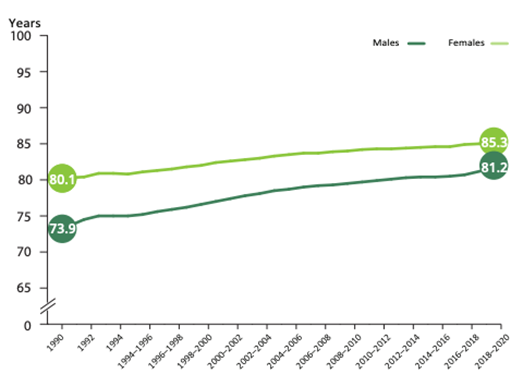
Source: AIHW, 2022, Australia’s Health Chapter Summaries. Accessed 12 July 2022.
Child and infant mortality
Child and infant mortality measures deaths in live born babies up to 1 year.
- Trend: increases in life expectancy in Australia are largely related to the substantial decrease in child and infant mortality.
Graph 4: Decline in infant mortality rate (per 1,000 live births), 1915-2020
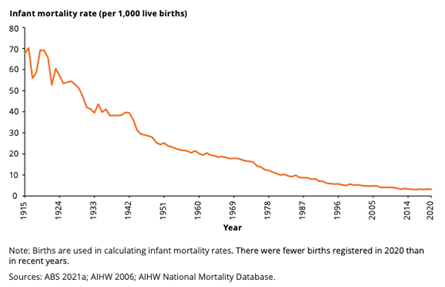
Source: AIHW, 2022, Australia’s Health Chapter Summaries. Accessed 12 July 2022.
Mortality rates
A fundamental aim of epidemiology is to determine whether levels of mortality are rising or falling over time, or whether they differ between population groups. Numbers alone are insufficient to measure differences because they do not account for population size. Mortality rates, on the other hand, are measures that are scaled to the size of the population.
Key trends:
- Cardiovascular diseases were the major cause of death for most years (Graph 5). Exceptions:
- 1919 – the Spanish influenza pandemic caused widespread mortality.
- From 2010 onwards – rates of death from cardiovascular diseases dropped below that from cancers, largely due to improvements in treatment and management.
- Cancer age-standardised rates were generally steady between 1970 and 2000 and have decreased since. This suggests changes in the age at death due to cancer over this period.
Graph 5: Age-Standardised mortality rates (per 100,000 population), by broad cause of death 1907-2020
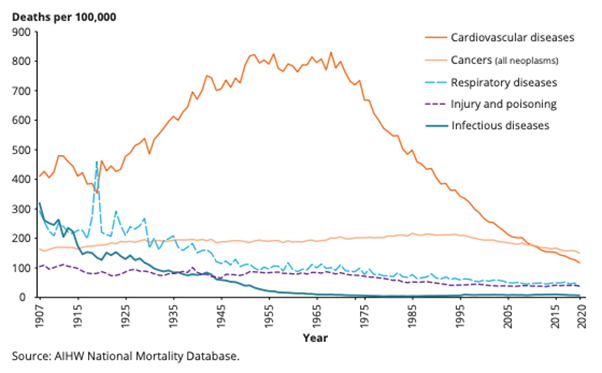
Source: AIHW, 2022, Australia’s Health Chapter Summaries. Accessed 12 July 2022.
More detailed information
Including additional tables and graphs about mortality rates for priority health conditions can be accessed at in the Australia’s Health 2022 – Data insights report


